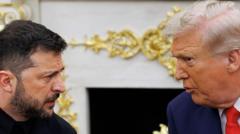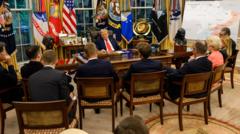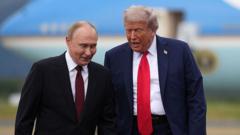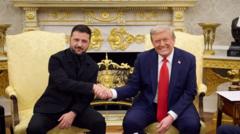The Canadian government will lift some of its retaliatory tariffs on U.S. imports starting September 1, while retaining tariffs on key sectors, aiming to restore free trade relations.
Canada Eases Retaliatory Tariffs on U.S. Goods
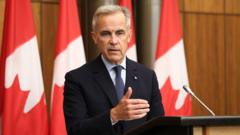
Canada Eases Retaliatory Tariffs on U.S. Goods
Canada's Prime Minister announces a reduction in tariffs, keeping only certain levies in place.
Canada’s Prime Minister Mark Carney announced on Friday that the country will reduce a portion of its retaliatory tariffs imposed on U.S. goods, although tariffs on automobiles, steel, and aluminum will remain effective. This announcement follows Carney's first telephone conversation with U.S. President Donald Trump after both nations failed to meet a trade agreement deadline.
Initially, Canada had implemented a 25% tariff on approximately C$30 billion (£16 billion; $21.7 billion) worth of American products, ranging from orange juice to home appliances. These duties were a direct response to U.S. tariffs that, as of August, reached 35% on Canadian goods that did not comply with existing free trade agreements.
Carney stated that Canada's move to remove tariffs on goods compliant with the US-Mexico-Canada Agreement (USMCA) will "re-establish free trade for the vast majority" of products exchanged between the two countries. This policy change is set to take effect on September 1.
In response, the White House expressed its approval of Canada’s decision, calling it "long overdue" and welcomed further discussions over trade and national security.
While Canada has been part of the list of countries facing U.S. tariffs as a result of Trump's global trade strategy, it is among only two nations, alongside China, that have enacted retaliatory tariffs against the U.S. Despite the ambiguity surrounding trade negotiations, recent polling indicates broad support among Canadians for retaliatory tariffs.
Carney, who rose to office after the April general election, promised a more combative stance in dealing with Trump, employing a popular hockey reference. When reporters inquired about potential shifts in Canada’s strategy, Carney pointed out that Canada presently enjoys a more favorable tariff arrangement with the U.S. due to the free trade agreement provisions, contributing to an effective tariff rate of about 5.6% on Canadian goods.
His administration’s objective is now to focus on expediting negotiations related to automobiles, steel, aluminum, lumber, and other crucial sectors ahead of an upcoming assessment of the USMCA in the following year. The U.S., meanwhile, currently imposes a 50% tariff on all steel and aluminum imports, save for those from the UK, along with a 25% levy on aluminum imports. Canada maintains its own 25% tariffs on U.S. steel, aluminum, and autos for the time being as trade dialogues continue.
As the global trade landscape evolves, President Trump has remained steadfast in his commitment to revise tariffs, creating ongoing tensions in international trade relations.
Initially, Canada had implemented a 25% tariff on approximately C$30 billion (£16 billion; $21.7 billion) worth of American products, ranging from orange juice to home appliances. These duties were a direct response to U.S. tariffs that, as of August, reached 35% on Canadian goods that did not comply with existing free trade agreements.
Carney stated that Canada's move to remove tariffs on goods compliant with the US-Mexico-Canada Agreement (USMCA) will "re-establish free trade for the vast majority" of products exchanged between the two countries. This policy change is set to take effect on September 1.
In response, the White House expressed its approval of Canada’s decision, calling it "long overdue" and welcomed further discussions over trade and national security.
While Canada has been part of the list of countries facing U.S. tariffs as a result of Trump's global trade strategy, it is among only two nations, alongside China, that have enacted retaliatory tariffs against the U.S. Despite the ambiguity surrounding trade negotiations, recent polling indicates broad support among Canadians for retaliatory tariffs.
Carney, who rose to office after the April general election, promised a more combative stance in dealing with Trump, employing a popular hockey reference. When reporters inquired about potential shifts in Canada’s strategy, Carney pointed out that Canada presently enjoys a more favorable tariff arrangement with the U.S. due to the free trade agreement provisions, contributing to an effective tariff rate of about 5.6% on Canadian goods.
His administration’s objective is now to focus on expediting negotiations related to automobiles, steel, aluminum, lumber, and other crucial sectors ahead of an upcoming assessment of the USMCA in the following year. The U.S., meanwhile, currently imposes a 50% tariff on all steel and aluminum imports, save for those from the UK, along with a 25% levy on aluminum imports. Canada maintains its own 25% tariffs on U.S. steel, aluminum, and autos for the time being as trade dialogues continue.
As the global trade landscape evolves, President Trump has remained steadfast in his commitment to revise tariffs, creating ongoing tensions in international trade relations.










